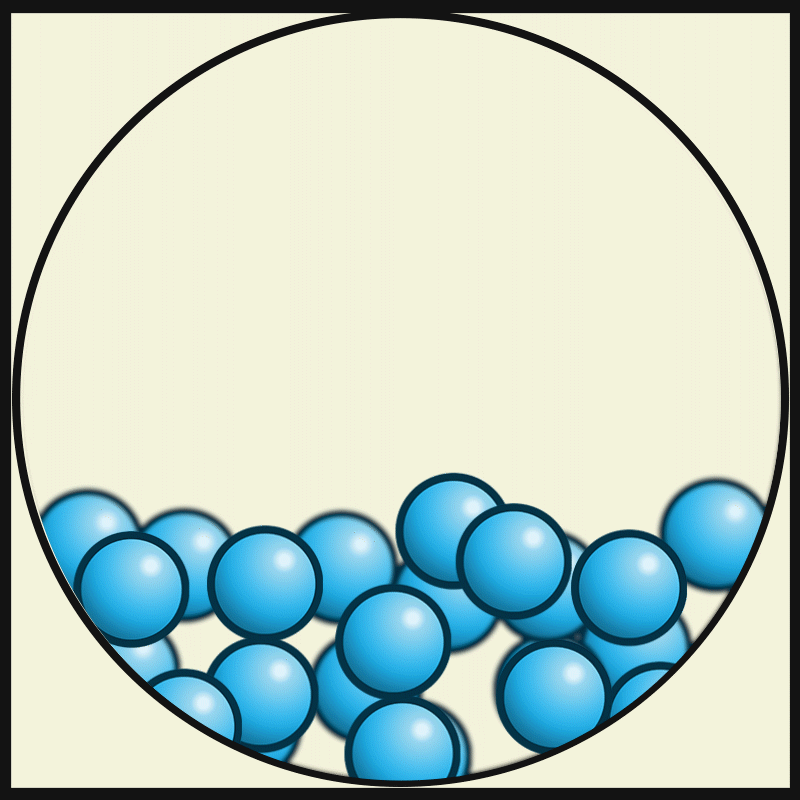A door is in which state of matter?
Solid
Drinking water is in which state of matter?
Liquid

Worth ONE... THOUSAND points.
Why does hot liquid water move faster than cold liquid water?
Heat makes particles loosen and move away. Cold water will have tighter (closer together) particles than hot water.
Milk is in which state of matter?
Liquid
What instrument is used to measure temperature?
Thermometer
We measure temperature in what units?
Degrees Celsius = oC
Define "temperature".
The measure of how hot or cold something is.
What is needed to change matter into a different state?
Heat. Add heat or remove heat (make colder).
"Condensation" describes a change between what two states of matter?
Gas becoming liquid.
"Melting" describes a change between what two states of matter?
Solid becoming liquid.
"Evaporation" describes a change between what two states of matter?
Liquid becoming gas.
"Freezing" describes a change between what two states of matter?
Liquid becoming solid.
Describe the particles of matter in a solid state.
They are very close together (tight).

Explain what "fixed" means.
Definite; does not change; stays the same.
Describe the particles of matter in a gas state.
They are far apart and fill their container.

Describe the particles of matter in a liquid state.
They are looser than a solid; they take the shape of their container.

Which state of matter is the easiest to compress? Why?
Gas. There is a lot of space between gas particles, unlike liquids and solids which have particles that are closer together.
Which state of matter is the most difficult to compress and why?
Solids because their particles are tightly packed (very close together).
A student checks their temperature twice a day for four days. How many times did they check their temperature and what is the highest temperature recorded?
The student checked eight (8) times. The highest temperature was 37.6 degrees Celsius.
Condensation is on the outside of a cold bottle of soda. Where did the liquid water come from?

The air. Water vapour in the (warmer) air condensed onto the (colder) can.
List at least three properties of matter in a gas state.
1) Can be compressed.
2) Can change shape.
3) Fill the container they are in.
4) Can be poured.
List at least three properties of matter in a liquid state.
1) Difficult to compress.
2) Take the shape of their container.
3) Can be poured.
4) Can flow.
List at least three properties of matter in a solid state.
1) Keep their shape (fixed or definite shape).
2) Cannot be poured.
3) Cannot be compressed (very difficult).
Your body is made up of what state(s) of matter?
Solid (bones, organs, etc.)
Liquid (blood, water, etc.)
Gas (air in your lungs, etc.)
This kettle is on a hot stove. Why do we see bubbles?

Liquid water at the bottom--closest to the source of heat--is hot enough to evaporate to gas. The gas bubbles float to the surface (top).
These people are in a very cold place. Explain what is happening.


Their bodies are hot. When cold air (gas) heats up, it condenses into liquid. The steam we see is made of tiny liquid particles.
You open the freezer door and see this. Explain what is happening.

Air in the room is warmer than air in the freezer. Water vapour (gas) in the air is cooled by the cold freezer air and condenses into small liquid water droplets.
Your skin makes sweat when you're hot. How does sweat cool your body?

Liquid water on the skin needs heat to evaporate to a gas. As the liquid water gains heat, the body loses heat and cools you.